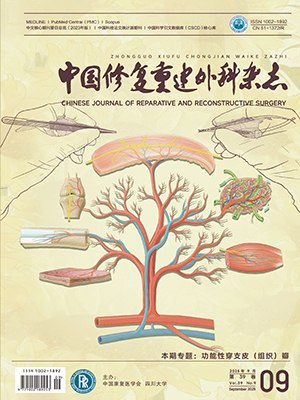| 1. |
Kim BG, Dan JM, Shin DE. Treatment of thoracolumbar fracture. Asian Spine J, 2015, 9(1): 133-146.
|
| 2. |
Jackson SA, Tenenhouse A, Robertson L. Vertebral fracture definition from population-based data: preliminary results from the Canadian Multicenter Osteoporosis Study (CaMos). Osteoporos Int, 2000, 11(8): 680-687.
|
| 3. |
Bruggink C, van de Ree CLP, van Ditshuizen J, et al. Increased incidence of traumatic spinal injury in patients aged 65 years and older in the Netherlands. Eur Spine J, 2024, 33(10): 3677-3684.
|
| 4. |
Wiersbicki DW, Osterhoff G, Heyde CE, et al. The relation of osteoporotic vertebral fractures and spine degeneration on the occurrence of complications: a systematic review. Eur Spine J, 2024, 33(8): 3213-3220.
|
| 5. |
Laughter MR, Maymone MBC, Karimkhani C, et al. The Burden of Skin and Subcutaneous Diseases in the United States From 1990 to 2017. JAMA Dermatol, 2020, 156(8): 874-881.
|
| 6. |
Melse JM, Essink-Bot ML, Kramers PG, et al. A national burden of disease calculation: Dutch disability-adjusted life-years. Dutch Burden of Disease Group. Am J Public Health, 2000, 90(8): 1241-1247.
|
| 7. |
李辉章, 杜灵彬. Joinpoint回归模型在肿瘤流行病学时间趋势分析中的应用. 中华预防医学杂志, 2020, 54(8): 908-912.
|
| 8. |
Luo Z, He Y, Ma G, et al. Years of life lost due to premature death and their trends in people with malignant neoplasm of female genital organs in Shanghai, China during 1995-2018: a population based study. BMC Public Health, 2020, 20(1): 1489. doi: 10.1186/s12889-020-09593-6.
|
| 9. |
《中国老年骨质疏松症诊疗指南2023》工作组, 中国老年学和老年医学学会骨质疏松分会, 中国医疗保健国际交流促进会骨质疏松病学分会, 等. 中国老年骨质疏松症诊疗指南 (2023). 中华骨与关节外科杂志, 2023, 16(10): 865-85.
|
| 10. |
GBD 2019 Fracture Collaborators. Global, regional, and national burden of bone fractures in 204 countries and territories, 1990-2019: a systematic analysis from the Global Burden of Disease Study 2019. Lancet Healthy Longev, 2021, 2(9): e580-e592.
|
| 11. |
张文胜, 宋振杰, 郭海威, 等. 椎旁肌功能横截面积预测骨质疏松性椎体压缩骨折. 中国组织工程研究, 2024, 28(33): 5315-5319.
|
| 12. |
Bliuc D, Alarkawi D, Nguyen TV, et al. Risk of subsequent fractures and mortality in elderly women and men with fragility fractures with and without osteoporotic bone density: the Dubbo Osteoporosis Epidemiology Study. J Bone Miner Res, 2015, 30(4): 637-646.
|
| 13. |
Ahmed LA, Center JR, Bjørnerem A, et al. Progressively increasing fracture risk with advancing age after initial incident fragility fracture: the Tromsø study. J Bone Miner Res, 2013, 28(10): 2214-2221.
|
| 14. |
Gu H, Shao B, Hu Y, et al. Epidemiological characteristics of traumatic spinal fractures among the elderly in China. Sci Rep, 2024, 14(1): 19170. doi: 10.1038/s41598-024-69780-y.
|
| 15. |
He Q, Yan Y, Mei J, et al. 3D-CT reconstruction for pedicle outer width assessment in patients with thoracolumbar spine fractures: a comparative analysis between age groups <60 years and ≥60 years. Front Surg, 2024, 11: 1407484. doi: 10.3389/fsurg.2024.1407484.
|
| 16. |
Shen Y, Shi Y, Gu X, et al. Using QCT for the prediction of spontaneous age- and gender-specific thoracolumbar vertebral fractures and accompanying distant vertebral fractures. BMC Musculoskelet Disord, 2024, 25(1): 828. doi: 10.1186/s12891-024-07961-6.
|
| 17. |
张亚军, 刘忠厚, 张鹏. 绝经后骨质疏松症流行病学研究进展. 中国骨质疏松杂志, 2010, 16(3): 229-234.
|
| 18. |
Horst-Sikorska W, Wawrzyniak A. The role of hormonal therapy in osteoporosis. Endokrynol Pol, 2011, 62(1): 61-64.
|
| 19. |
王洪伟, 李长青, 王建, 等. 老年人外伤性脊柱骨折的临床特点. 中国脊柱脊髓杂志, 2012, 22(12): 1072-1076.
|
| 20. |
陈国强, 方秀统, 俞猛. 老年外伤性脊柱骨折的临床特点及预防分析. 上海交通大学学报(医学版), 2014, 34(10): 1493-1496.
|
| 21. |
赵凯平, 袁蕊, 马楠, 等. 55岁以上原发骨质疏松性骨折患者特征及趋势分析. 中国骨质疏松杂志, 2020, 26(6): 849-856.
|
| 22. |
朱福林, 李洪涛, 何曼青. 中国式现代化高质量发展路径研究. 全球化, 2025, (1): 84-94, 134-135.
|
| 23. |
高子茗, 吕洋. 新业态发展与城市内部经济不平衡. 财贸经济, 2024, 45(9): 110-124.
|
| 24. |
姜效韦, 朱冬梅, 王明宇, 等. 2 887例老年骨质疏松性脊柱压缩性骨折流行病学特点分析. 医药前沿, 2024, 14(15): 8-11+15.
|
| 25. |
丁立祥, 宋继鹏. 骨质疏松性脊柱骨折的外科治疗策略及发展趋势. 中国骨伤, 2025, 38(2): 109-113.
|




